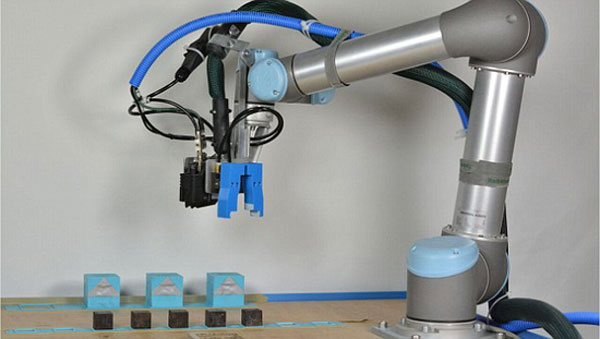


File photo of a mother robot (R), which is developed by scientists from the University of Cambridge, U.K., independently makes its own child robots (L). (File Photo)
Scientists from the University of Cambridge have developed a mother robot that independently builds its own baby robots and then tests their performances to inform the future design.
The mother robot first glues one to five modules together to make a child robot and put a slightly-different motor inside each cube. Then it tests how far each cube moves from a starting point in a certain amount of time, with the best individual's traits carried over into the next generation.
The lead researcher Dr Fumiya Iida said their experiments bring about interesting results.
"The mother robot can actually build hundreds of child robots and see the performance of these child robots and, if their performance is good, keep their design for the next generation. And if bad, just let it go. And just repeating this iterative design improvement processes, the mother robot can actually gradually improve the performance of the child robot,"
Dr Fumiya Lida also said the mother robots produced a large number of robotic offspring.
"The largest experiment that we did so far, we built 500 robots; the mother robot generated 500 robots to see what one is good and which one is bad. And after all, we found quite an interesting design, the design of the child robots, that is very difficult for humans to design."
While the idea of a mother robot that autonomously builds better and better baby robots sounds like a premise for a science fiction film, this super mother robot's ability, in fact, is determined by a reward program.
Andre Rosendo, who worked on the project at the University's Department of Engineering, explains how the reward program works.
"We program the robot based on some functions that define the reward that the robot is going to get depending on the construction that they make. They cannot change their own reward. And as the robot evolves, trying to maximize the reward that we give them, they try to reach better behaves (behavior). In the case of children robot, it's distance. So the longer the distance that the robot walks, the better the reward that it receives,"
The research team in Cambridge says their robots are mimicking nature's evolutionary mechanism of survival of the fittest, and can be applied to manufacturing.
"When you go to industries and you have, for example, a factory that makes cars; if you could have robot cameras evaluating how each car is being created, and from the mistakes that you had in the operation you could just re-do for the next car and for the next car, and you keep re-doing it - at the end you're going to have amazing cars."
So far, the mother robot needs about ten minutes to design, build and test a baby robot it produced.
The scientists hope they could eventually use a computer simulation to pre-select the best robot designs and use real models for actual testing.
 'Enemy planes' intercepted by Hongqi-7B air-defense missiles
'Enemy planes' intercepted by Hongqi-7B air-defense missiles Blind date with bikini girls in Nanjing
Blind date with bikini girls in Nanjing Amazing photos of Chinese fighter jets
Amazing photos of Chinese fighter jets Chinese soldiers participate in training for V-Day parade
Chinese soldiers participate in training for V-Day parade Painting: Lonely women in Forbidden City
Painting: Lonely women in Forbidden City China and Russia hold joint drill in Sea of Japan
China and Russia hold joint drill in Sea of Japan 'Goddess' in Taiwan McDonald's
'Goddess' in Taiwan McDonald's Female soldiers at military parades
Female soldiers at military parades Photos of campus belle doing splits go viral
Photos of campus belle doing splits go viral Best blade forward
Best blade forward Infographic: Parsing China's massive V-day parade
Infographic: Parsing China's massive V-day parade Giant panda cub receives medical care in Guangzhou
Giant panda cub receives medical care in Guangzhou China celebrates 70th Anniversary of Victory of World Anti-Fascist War
China celebrates 70th Anniversary of Victory of World Anti-Fascist WarDay|Week